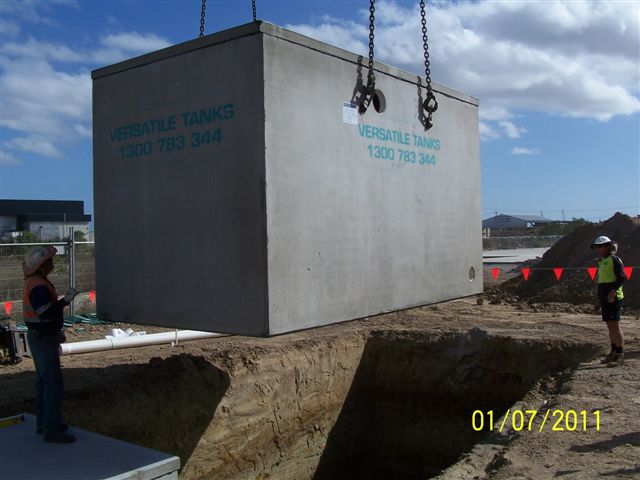Detention tanks are an effective tool for hoarding storm water runoff before releasing it downstream in a controlled manner. Think of it as a mini-dam of sorts where you gradually drain the vessel when it’s already filled to the brim. Detention water tanks Sydney made are now required for new commercial constructions or renovated developments.
Detention water tanks Australia produced are utilised to collect stormwater. Perhaps it’s best to distinguish the container from the average catchment basin that collects rainwater.
The average catchment harvests rain that falls off the roof onto the storage tank. You can then repurpose the collected water to water plants or yards, for pets and livestock, for agricultural irrigation, and even for drinking water as long you adequately treat it.
However, detention water tanks are heavy-duty receptacles that harvest rainwater that fall from the room down to the downpipes and gutters, including the water runoff from driveways, lawns, roads, and gardens.
Retention vs Detention Water Tanks in Sydney
The main difference between the retention and detention water tank is its purpose.
You can purchase a retention tank to harvest storm water only if you intend to use the collected water for a lengthy period. For instance, you may use the harvested rainwater and storm water to wash your driveway or maintain your garden. You could even utilise the rainwater to flush your toilets.
Meanwhile, we designed our detention water tanks Sydney made to store water for a limited period. After that, you can repurpose the harvested water for something else. Instead, drain or rechannel the liquid elsewhere to avoid flooding the commercial property or construction site.
The distinguishable feature of the detention tank is the valve that allows you to release water gradually, depending on your need.
The detention tank must be empty during the wettest month, which is typically June. Meanwhile, you can afford to leave the tank filled for the meantime during September, which is Sydney’s driest month.
How large Are Retention or Detention Tanks?
Retention tank sizes vary according to commercial or household needs.
For instance, GWM Water estimates that Australians use 3-6 litres every time they flush using a dual cistern. Meanwhile, a single-flush cistern uses from nine to eleven litres per flush. Showerheads use between nine and 19 litres per minute, while the washing machine uses about 50 litres.
If you are a garden sprinkler at home, you will waste about 1,000 litres per hour.
Meanwhile, our underground detention water tanks Sydney made come in different sizes.
1. We have the 6700 Litre Water Tank. It’s made of concrete and has the following dimensions:
● Height – 2100mm
● Width – 2100mm
● Length – 1800mm
● Weight – 4.1 ton
2. You can also choose our 11700 Litre Water Tank. It’s also made of concrete and has the following dimensions:
● Height – 2400mm
● Width – 2400mm
● Length – 2400mm
● Weight – 7.1 ton
3. Finally, we have the 22500 Litre Water Tank. The concrete storm water container has the following dimensions:
● Height – 2600mm
● Width – 2400mm
● Length – 4400mm
● Weight – 11.7 ton
We can install the detention water tanks Sydney made underground or above-ground. For instance, our team will install it on your driveway or garage slab. We can also choose a location underground where the detention tank is invisible, thereby maintaining your curb appeal.
We can also customize the size according to the requirements of your local council or homeowners association. We fitted out tanks with customisable orifice plates that effectively control the water flow draining to the storm water system. The meshed cover will ensure that water will not back up to the detention tank.
Mixed-Use Tanks
By installing a detention tank, you effectively increase the capacity of your drainage or storm water system to handle the deluge of water from a heavy downpour.
In recent years, local councils have mandated new commercial property owners to invest in detention tanks to manage runoff.
However, retention and detention water tanks Australia produced are not mutually exclusive.
No law prohibits you from simultaneously installing a retention and detention water tank. Versatile Tanks even recommends this option if you have the budget for it. However, you still have to talk with your local council regarding the size of the detention tank installed on your property.
Alternatively, specially fabricated water tanks Sydney can function as both a retention and detention system.
Conclusion
Sydney’s development has accelerated these past few years, so your development site might be at risk of dealing with runoff water since the drainage is clogged. With the detention water tank, you can now avoid a sudden deluge of storm water, preventing floods from damaging your property or inconveniencing inhabitants and tenants.
Detention water tanks Australia made are your last line of defence against surface flooding. Ideally, the contractor must have a comprehensive draining plan in place to secure all the inhabitants and properties against damage. However, detention tanks are necessary to ensure that you will not be caught unaware during an intense downpour.

